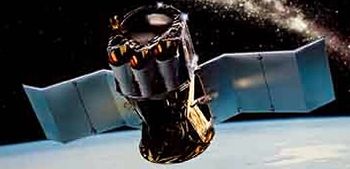
Home - Search - Browse - Alphabetic Index: 0- 1- 2- 3- 4- 5- 6- 7- 8- 9
A- B- C- D- E- F- G- H- I- J- K- L- M- N- O- P- Q- R- S- T- U- V- W- X- Y- Z
SWAS
 SWAS Credit: Manufacturer Image |
AKA: SMEX;Submillimeter Wave Astronomy Satellite. Status: Operational 1998. First Launch: 1998-12-06. Last Launch: 1998-12-06. Number: 1 . Gross mass: 288 kg (634 lb).
SWAS was used to study the cooling of molecular cloud cores, the sites of star formation in the Milky Way galaxy, by measuring lines from molecular oxygen and water.
NASA NSSDC Master Catalog Description
SWAS (Submillimeter Wave Astronomy Satellite) is part of NASA's Small Explorer (SMEX) program. The SWAS instrument is a submillimeter wave telescope launched on December 2, 1998 and operated in a 600 km circular orbit with 70 degree inclination. Scientific objectives of SWAS are to study the chemical composition, energy balance and structure of interstellar clouds, both galactic and extragalactic, and the processes that lead to the formation of stars and planets.
SWAS focuses on the following spectral lines: (1) water molecule at 556.936 GHz; (2) oxygen molecule at 487.249 GHz; (3) CI at 492.161 GHz; (4) carbon 13 monoxide molecule at 550.927 GHz; and, (5) oxygen 18 water molecule at 548.676 GHz). Detailed 1 degree x 1 degree maps of giant molecular and dark cloud cores are generated from a grid of measurements taken at 3.7 arc-min spacings. SWAS's submillimeter radiometers are a pair of passively cooled subharmonic Schottky diode receivers, with receiver noise figures of 2500-3000 K. An acousto-optical spectrometer (AOS) was provided by the University of Cologne. Outputs of the two SWAS receivers are combined to form a final intermediate frequency, which extends from 1.4 to 2.8 GHz and is dispersed into 1400 1 MHz channels by the AOS.
SWAS has a 55 x 71 cm elliptical off-axis Cassegrain telescope with a beam width of 4 arc-min at operating frequencies. SWAS is designed to make pointed observations stabilized on three axes, with a position accuracy of about 38 arc-s, and jitter of about 24 arc-s. Attitude information is obtained from gyros whose drift is corrected via a star tracker. Momentum wheels are used to maneuver the spacecraft.
Family: Astronomy, Infrared astronomy satellite, Medium earth orbit. Country: USA. Launch Vehicles: Pegasus, Pegasus XL. Projects: Small Explorer. Launch Sites: Point Arguello WADZ. Agency: NASA, NASA Greenbelt. Bibliography: 2, 4.
1998 December 6 - . 00:57 GMT - . Launch Site: Point Arguello. Launch Complex: Point Arguello WADZ. Launch Pad: Aircraft from Vandenberg.. Launch Platform: L-1011. LV Family: Pegasus. Launch Vehicle: Pegasus XL.
- SWAS - .
Nation: USA.
Agency: NASA Greenbelt.
Program: Small Explorer.
Class: Astronomy.
Type: X-ray astronomy satellite. Spacecraft: SWAS.
USAF Sat Cat: 25560 . COSPAR: 1998-071A. Apogee: 611 km (379 mi). Perigee: 599 km (372 mi). Inclination: 69.90 deg. Period: 96.80 min.
On December 3 the Orbital Sciences L-1011 Stargazer took off from Vandenberg AFB Runway 30/12 carrying a Pegasus XL launch vehicle with the SWAS satellite aboard. It reached the drop box at 36.0N 123.0W over the Pacific, but due to a software-related problem the range ordered the launch scrubbed and the L-1011 returned to base. After a further delay due to weather, the L-1011 took off at 23:58 GMT on December 5 and SWAS reached orbit and separated from the third stage at 01:09 GMT. SWAS, the Sub-millimetre Wave Astronomy Satellite, had a 0.6m telescope with a 490 to 550 GHz sub-millimetre receiver and an acousto-optical spectrometer. SWAS was used to study the cooling of molecular cloud cores, the sites of star formation in our galaxy, by measuring lines from molecular oxygen and water. Air dropped in Point Arguello WADZ.
Back to top of page
Home - Search - Browse - Alphabetic Index: 0- 1- 2- 3- 4- 5- 6- 7- 8- 9
A- B- C- D- E- F- G- H- I- J- K- L- M- N- O- P- Q- R- S- T- U- V- W- X- Y- Z
© 1997-2019 Mark Wade - Contact
© / Conditions for Use